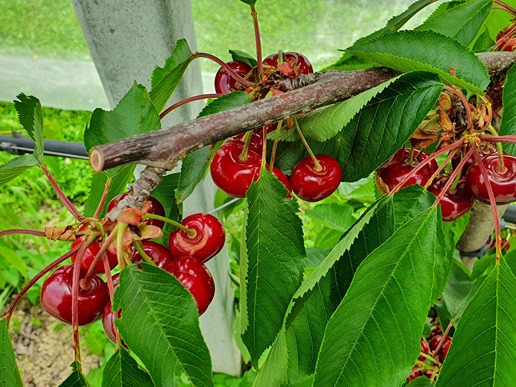The role of genes related to anthocyanin and flavonoid synthesis in fruit development has recently been highlighted in a transcriptomic analysis, and the results showed how the plant reproduction process, disease resistance, and stress tolerance can be significantly influenced by the presence or absence of these compounds.
Chemically, flavonoids are specialized metabolites formed through the phenylpropanoid pathway, and fruits are typically rich in these compounds, which contribute to their color and flavor.
Thanks to their structural conformation, they possess powerful antioxidant activity capable of eliminating free radicals, with positive implications for human health.
Cherry genome and flavonoid genes
Furthermore, in cherries, the differential expression of phenylalanine ammonia-lyase (PAL), cinnamate 4-hydroxylase, and 4-coumarate-CoA ligase has been suggested by some studies as a factor influencing flavonoid biosynthesis.
However, studies on the evolution of the cherry genome conducted so far were incomplete, as they were based on incomplete genome sequencing.
At the Northwest University in China, thanks to the use of sophisticated sequencing technologies, researchers have produced an assembly of the sweet cherry genome cv. Tieton.
Comparative genomic analysis considered eight angiosperm genera, including Prunus armeniaca (apricot), P. persica (peach), P. mira (Tibetan peach), P. yedoensis (sakura or Japanese cherry), and P. avium (cherry) cv. Tieton, with Arabidopsis thaliana, Populus trichocarpa, and Vitis vinifera as outgroups, in order to gain a more comprehensive understanding of the "Tieton" genome characteristics and its relationship to representative species within the genus Prunus.
Comparative genomics and gene families
A total of 29,915 orthologous gene families were identified, containing 300,918 genes across all eight species.
These species shared 10,506 gene families with 153,491 genes, of which 173 were single-copy gene families.
Specifically, the "Tieton" genome contained 1100 unique genes.
Subsequent analysis indicated that these genes could be crucial for the species' environmental adaptation and could explain its remarkable stress resistance.
Evolution and metabolite analysis
"Tieton" shares 16,771, 16,208, 16,030, and 17,304 gene families with apricot, Tibetan peach, peach, and sakura, respectively.
To determine the evolutionary relationships and divergence of the eight species, a phylogenetic tree was constructed.
The results suggested that Prunus species diverged from dicotyledonous plants approximately 90.9–72.8 million years ago, while the divergence between "Tieton" and sakura (P. yedoensis) occurred approximately 23.2–9.9 million years ago.
Integrative analyses of genomics, transcriptomics, and metabolomics have identified several critical structural genes and metabolites that are essential for flavonoid biosynthesis in sweet cherry.
Key flavonoids in cherry tissues
Specifically, the study demonstrated that 85 specialized metabolites accumulate in a highly differentiated manner in five different cherry tissues: the flesh, the stem, the leaf, the bud, and the seed.
In cherry flesh tissues, eight flavonoids were present in large quantities.
Gene-metabolite correlation analysis then demonstrated that the accumulation of flavonoids in cherry flesh was substantially regulated by seven genes.
These findings provide interesting insights into the mechanisms of genome evolution and flavonoid biosynthesis, as well as a solid foundation for further functional genomics research and cherry breeding.
Source: Tong Zhou, Xiao-Juan Huang, Yan-Jun Cheng, Xing-Ya Zhang, Xiao-Juan Wang, Zhong-Hu Li, Telomere-to-telomere genome and multi-omics analysis of Prunus avium cv. Tieton provides insights into its genomic evolution and flavonoid biosynthesis, International Journal of Biological Macromolecules, Volume 306, Part 4, 2025, 141809, ISSN 0141-8130, https://doi.org/10.1016/j.ijbiomac.2025.141809
Image source: World Fresh
Melissa Venturi
University of Bologna (IT)
Cherry Times - All rights reserved












